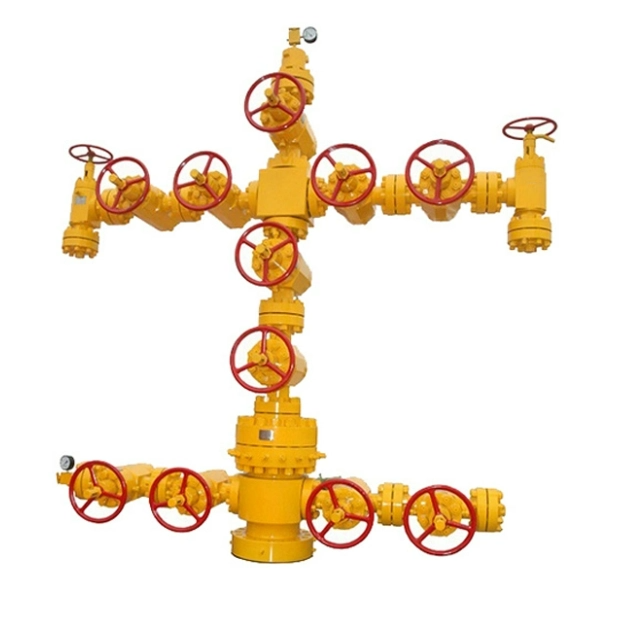
Introduction
In the complex world of oil and gas extraction, the Wellhead Christmas Tree plays a critical role. Serving as the core pressure control assembly atop an oil or gas well, the Christmas Tree is far more than a decorative name—it’s a vital part of the infrastructure that ensures safe, efficient, and continuous production. But one key question frequently arises: What materials are used to manufacture a Wellhead Christmas Tree?
To answer that, we must delve into the intense conditions these systems endure. From extreme pressure and temperature to corrosive fluids and sour gas (H₂S), the materials selected for a Christmas Tree must perform without failure. Any compromise could lead to catastrophic operational, environmental, or financial consequences. Hence, material selection isn't just a design choice—it's a critical safety mandate.
Primary Materials Used in Wellhead Christmas Trees
Material selection for Wellhead Christmas Trees is driven by mechanical strength, corrosion resistance, temperature endurance, and compatibility with harsh fluids. Below are the primary materials commonly used:
1. Carbon Steel – The Foundation Material
Carbon steel is the workhorse material in most standard wellhead applications. It offers high mechanical strength, machinability, and cost-efficiency.
Grade Examples: AISI 4130, ASTM A105
Applications: Body components, flanges, bonnets
Carbon steel is often heat-treated (quenched and tempered) to improve strength and toughness. However, it has a lower resistance to corrosion, which means additional protective coatings, cladding, or chemical treatments (e.g., phosphate coatings) are often required.
Despite its limitations, carbon steel remains prevalent due to its affordability and mechanical performance, particularly in sweet (non-sour) service conditions.
2. Stainless Steel – Enhanced Corrosion Resistance
Stainless steel is widely used in Wellhead Christmas Trees for its excellent corrosion resistance, especially in sour environments where hydrogen sulfide is present.
Common Grades: 316, 304, 17-4 PH
Applications: Valve trims, stems, sealing surfaces
Stainless steels form a chromium-rich oxide layer that offers exceptional resistance to corrosion. Precipitation-hardened stainless steels (like 17-4 PH) provide a balance of strength and corrosion resistance, making them ideal for moving parts subject to wear and tear.
In sour gas applications, stainless steels are often selected for compliance with NACE MR0175/ISO 15156 standards for H₂S resistance.
3. Inconel and Other Nickel-Based Alloys – Extreme Condition Champions
When operating in ultra-sour or high-pressure high-temperature (HPHT) wells, nickel-based alloys like Inconel 625 and Inconel 718 become indispensable.
These alloys offer:
Excellent resistance to stress corrosion cracking
High mechanical strength even at elevated temperatures
Compatibility with aggressive acids and sour gas
Due to their premium performance, these materials are significantly more expensive and usually reserved for the most severe service conditions.
Cladding and Surface Treatment Technologies
Even when the main structure is carbon steel, many Wellhead Christmas Trees undergo cladding or overlay welding to enhance corrosion resistance.
CRA Cladding (Corrosion-Resistant Alloy Cladding)
This involves welding a thin layer of corrosion-resistant material—such as Inconel or stainless steel—onto the internal surfaces of components.
Purpose: Combines cost-effective carbon steel base with corrosion-resistant surface
Method: Weld overlay, explosion bonding, or centrifugal casting
This method is particularly useful in reducing costs while maintaining high performance in aggressive well environments. Cladded components are often used in flow passages, valve bodies, and sealing interfaces.
Elastomers and Non-Metallic Materials in Sealing Systems
While metals make up the bulk of the structure, non-metallic materials are equally important—especially in sealing and isolation.
Elastomers – Critical for Leak Prevention
Common Materials: Nitrile (NBR), Viton (FKM), HNBR, PTFE
Applications: O-rings, gaskets, and seals
These materials must withstand exposure to hydrocarbons, H₂S, high pressure, and temperature fluctuations. HNBR (Hydrogenated Nitrile Butadiene Rubber) is favored for its chemical resistance and temperature durability. For ultra-demanding applications, PTFE and perfluoroelastomers are used for their superior inertness and performance.
Material compatibility is crucial. An incompatible elastomer can degrade, swell, or crack—compromising the entire system's integrity.
Material Comparison Table
Below is a comparative table summarizing the core materials used in Wellhead Christmas Trees:
| Material Type | Common Grades | Applications | Strength | Corrosion Resistance | Cost |
| Carbon Steel | AISI 4130, A105 | Body, flanges, bonnets | High | Low | Low |
| Stainless Steel | 316, 304, 17-4PH | Valve trims, stems, sealing areas | Moderate | High | Medium |
| Inconel (Nickel Alloys) | 625, 718 | Valves, seals, bolts | Very High | Very High | High |
| CRA Cladding | Inconel, SS | Internal surfaces of steel parts | N/A | Very High | Medium |
| Elastomers | HNBR, Viton, PTFE | Seals, O-rings, gaskets | Low | Varies by type | Low–High |
Frequently Asked Questions (FAQ)
Q1: Why is Inconel preferred in HPHT environments?
Answer: Inconel alloys maintain high strength and resist corrosion even at extremely high temperatures and pressures. Their ability to resist chloride-induced stress corrosion cracking and sulfide stress cracking makes them ideal for HPHT and sour service wells.
Q2: Can carbon steel be used in sour gas wells?
Answer: Generally, no—unless the carbon steel is qualified under NACE MR0175 and used in less aggressive environments. Sour gas causes sulfide stress cracking in unprotected carbon steel, so cladding or full CRA components are preferred.
Q3: Are non-metallic materials like rubber safe for high-pressure sealing?
Answer: Yes, if selected correctly. Advanced elastomers like HNBR and Viton offer excellent sealing performance under high pressure and temperature. However, incorrect selection can lead to seal failure, so engineering analysis is essential.
Conclusion
The Wellhead Christmas Tree is a cornerstone of oilfield engineering, designed to handle extreme conditions with unfailing reliability. The secret behind its robust performance lies in the careful selection of materials, each chosen based on environmental conditions, expected loads, and required longevity.
From affordable carbon steel to advanced Inconel alloys and precision elastomers, every component plays a vital role. The interplay of strength, resistance, and compatibility ensures that these critical systems continue to function safely and effectively—often for decades.
In the end, selecting the right material is not just about durability—it’s about safety, efficiency, and long-term operational success.





















